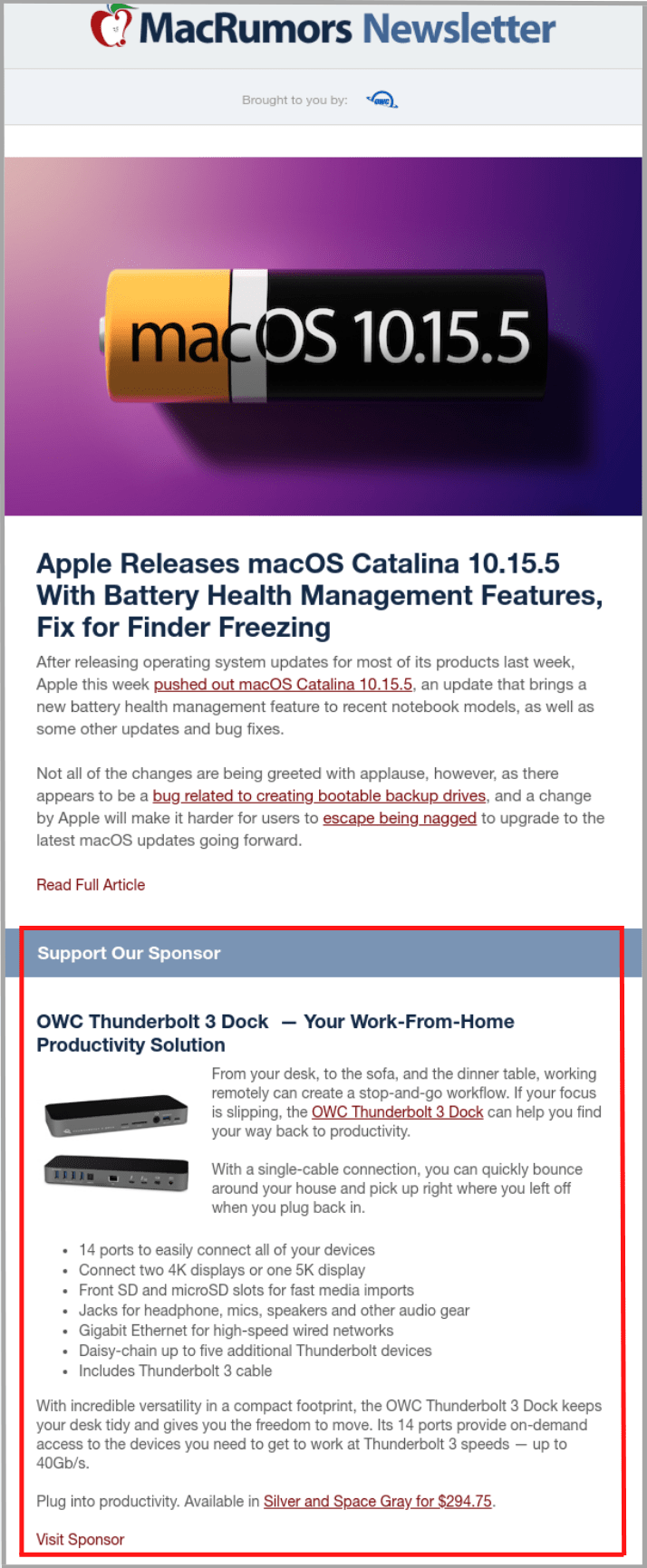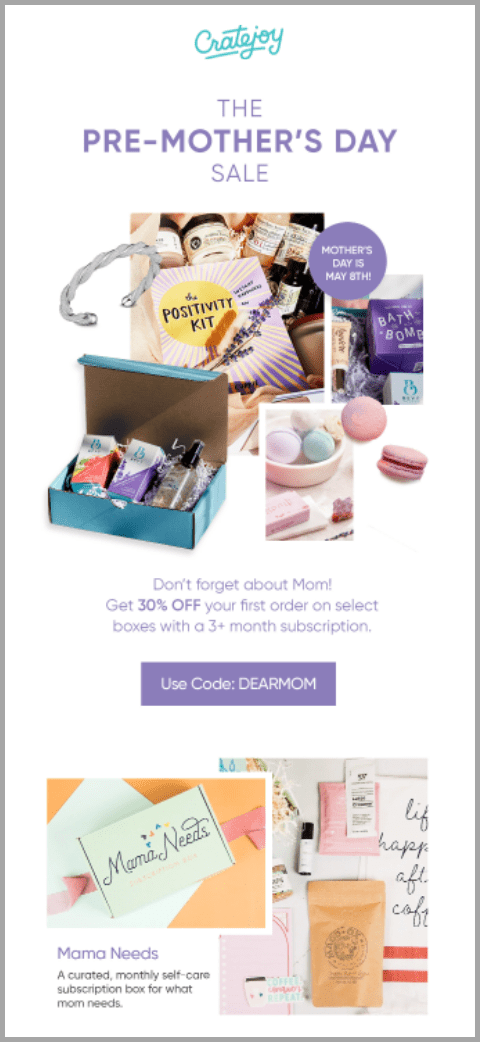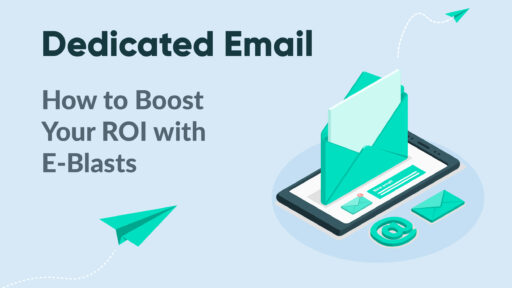It’s no secret that newsletters are on the rise. Just ask any business that recently acquired an email media company, or a journalist who left a well-known publication to start their own solo venture–newsletters are the future, and everyone wants a piece of the action.
With the increase in newsletter popularity, we’re also seeing more creative ways of monetizing them, including the newsletter sponsorship.
A newsletter sponsorship is a form of monetization in which a creator sells space in their newsletter to advertisers interested in promoting their brand to a publication’s audience. Creators have increasingly adopted newsletter sponsorships as a revenue generation strategy, either instead of or in addition to traditional monetization methods like paid subscriptions.
In this guide, we’ll take you through the ins and outs of newsletter sponsorship, including pricing, alternatives, and how to run one on your own.
What is a newsletter sponsorship?
A newsletter sponsorship is a paid placement within an email newsletter. However, unlike a typical ad, it tends to be more natively integrated into the surrounding content. To get a better idea of the difference between ads and sponsorships, let’s put it in the context of other mediums like YouTube videos or podcasts.
While a YouTube ad plays between the videos, a sponsorship appears within the video itself. The creator will often use their own voice to present it as entertaining and relevant content to avoid disrupting the experience. Not only does this make it harder to skip, but it also creates a more engaging pitch that viewers are more likely to enjoy.

With a newsletter sponsorship, you’re getting the same enhanced experience, but in the form of an email newsletter. However, just like video sponsorships, the design and format of each newsletter sponsorship can vary by publication. That’s why it’s important to set clear expectations with each partner beforehand.
Types of newsletter sponsorships
Each newsletter sponsorship typically falls into one of two main categories: sponsored and dedicated emails. While a sponsored email consists of a single placement within a newsletter, a dedicated email takes up the entire page with advertiser content.
Sponsored email
Sponsored emails appear alongside regular newsletter content, allowing them to blend in with the issue as a whole. Some publishers will even work with their newsletter sponsors to design a sponsored email to fit their brand style.

Sponsored emails may appear in several forms, including:
- Featured headers
- Native ads
- Display ads
- Classifieds
Due to their size, they tend to be a much cheaper option than dedicated emails. For that reason, many advertisers will run them in an initial test across a large batch of newsletters to see what works.
Dedicated email
Dedicated emails are entirely devoted to a single sponsorship placement. This allows the advertiser to retain full control over their design. However, the email will typically also include the newsletter’s sender name and logo to distinguish it from unsavory alternatives like purchased lists.

Since dedicated emails enable exclusive access to a valuable audience, they tend to be significantly pricier than their sponsored email counterparts. In turn, they also generate higher engagement and better results.
Newsletter sponsorships vs. email marketing
Even outside of newsletters, many advertisers are beginning to see the value of email as a whole. It’s no wonder, as studies have shown that $1 invested in email yields $42 in ROI. Furthermore, 4 out of 5 marketers say that they’d prefer to give up social media than email marketing.
Due to its high returns, experts are increasingly promoting the value of incorporating email into your marketing strategy. However, email marketing and newsletter sponsorships aren’t one and the same. Rather, each practice can play a unique role in your business plan.
Read: Email Marketing vs. Newsletter Advertising: What’s the Difference?
What is email marketing?
Email marketing is a form of direct marketing in which a company will send out email communications to a list of opt-in subscribers who are interested in their brand. These emails will consist of a variety of messages, including welcome emails, company announcements, and special offers.

Email marketing is one of the most effective ways to nurture leads and educate customers. Because email enables direct access to recipients, it allows marketers to continuously connect with their target audience and build relationships over time.
All types of companies use email marketing to reach their business goals. Whether you’re aiming to educate new customers about your software or announce an upcoming product launch, email marketing is one of the best ways to get it done.
How do newsletter sponsorships compare to email marketing?
Even if you’re good to go on the email marketing front, newsletter sponsorships are still key to generating leads and reaching new audiences. That’s because running a newsletter sponsorship allows you to tap into a new subscriber base– perhaps one that you wouldn’t be able to access through other channels.
While you can certainly expand your reach from growing your email list, it’s a slow and tiring process. On the other hand, booking a single sponsorship in a popular newsletter can give you access to millions of new readers in no time at all.
Aside from helping you reach new audiences, newsletter sponsors can also save valuable time and resources. While email marketing can play a critical role in establishing your brand value, it also requires significant investment. From building your list to designing your emails, the work can add up quickly.
With a newsletter sponsorship, by contrast, you don’t have to worry about any of that. That’s not to say that running a newsletter sponsorship is always preferable to launching an email marketing campaign. Rather, each strategy presents its own strengths and limitations for your business plan.
Benefits of running a newsletter sponsorship
Compared to other advertising channels like PPC or social media ads, newsletter sponsorships tend to fly under the radar. However, every business can benefit from adding email sponsorships to their arsenal for a few main reasons.
1. Achieve built-in targeting
Newsletters come in all shapes and sizes, with many publications focusing on specific interests. For instance, a few niche newsletters in the Paved Marketplace include:
- Vegetarian Times: a resource for people who want to live a mindful lifestyle, including eating ethically and sustainably-sourced foods
- Millo: a weekly newsletter focused on helping freelancers and solopreneurs win at business
- The Street Sheet: a five-minute briefing for city-dwelling 25-55-year-olds in the finance industry
Because newsletter audiences often consist of specific, interest-based communities, you can easily find a publication that aligns with your target audience. For instance, if you’re advertising a SaaS product to help software teams track their projects, you’ll want to start by looking at tech newsletters geared toward PMs and developers. This strategy will increasingly come in handy as advertisers shift away from third-party cookies.
2. Reach audiences directly
Regardless of the format, each newsletter ad is sent straight to your audience’s email inbox. By opting for a streamlined delivery method, you can bypass ad blockers and guarantee that readers will receive your message.
3. Build credibility
Running a newsletter sponsorship allows you to boost brand awareness by partnering with a high-quality publication that subscribers enjoy. By associating your company with a trusted newsletter, you’ll be able to borrow the credibility that they’ve built over time.
Contrastingly, many social media platforms may have the opposite effect. In fact, according to a Washington Post-Schar School poll, 72% of internet users trust Facebook not much or not at all. While this certainly doesn’t mean that running Facebook ads will deem your brand untrustworthy, placements on the platform may be met with a higher degree of skepticism.
Programmatic email advertising: a close alternative
We can’t talk about newsletter sponsorships without mentioning programmatic email advertising. This digital marketing channel, like any form of programmatic advertising, allows businesses to leverage granular targeting through automated ads.
For instance, let’s say you want to target startup employees in the US from ages 30-45. Rather than looking for a publication with that exact demographic, you would launch a campaign in the Paved Ad Network and set your target audience accordingly.
From there, you can add specifications like your budget, frequency cap, and run dates. Then, your ad placement will appear across several newsletters to get in front of subscribers within your specified audience.
Programmatic email ads present unique advantages to advertisers, such as enhanced targeting and scalability. However, they’re also more limited in their customization options. For that reason, they’re unable to achieve the same native design as individually coordinated sponsorships.
How much does a newsletter sponsorship cost?
When it comes to running a newsletter sponsorship, pricing is one of the trickiest areas to navigate. Especially if you’re new to the game, it’s hard to tell what qualifies as a good rate.
Typically, newsletter sponsorships are priced in terms of CPM, or cost per mille. Outside of the sponsorship world, this typically refers to the cost for every 1000 impressions. However, email impressions are determined by opens, which are unpredictable and difficult to measure. That’s why in newsletter sponsorships, CPM is based on cost per thousand subscribers.
For a healthy, high-quality email newsletter, many advertisers aim for a CPM around $15-30 for a sponsored email. However, this rate can increase for more niche, valuable audiences.
The good thing about CPM is that it’s simple and easy to calculate. However, it also highlights email list size as the primary factor in a sponsorship’s value. Unfortunately, that’s not always the case. In fact, a small newsletter with active readership can end up yielding more clicks and opens than a much larger newsletter with an unengaged subscriber base.
At Paved, we recommend evaluating newsletters based on CPC (cost per click). That way, you can more accurately estimate your expected performance from a given campaign. To calculate cost per click, request average click data from the publisher. If you’re using the Paved Marketplace, you can access that information directly from their profile, along with a distribution of recent performance.
Then, calculate sponsorship cost divided by average number of clicks to get estimated CPC. From there, you can also plug in your landing page conversion rate to predict your CPA from that campaign.
Want to explore newsletter pricing on your own? Check out our calculator.
How to run a newsletter sponsorship
Running a high-performing newsletter sponsorship is far from an exact science. Most advertisers test out a few different placements before figuring out what works best for their brand. However, getting familiar with the sponsorship process can help set you up for success.
Read: How To Run Newsletter Sponsorships in 2024
1. Identify a goal
Before launching your sponsorship, you’ll need to identify what you want to get out of it. Here are a few common examples of advertising goals:
- Sell a product or service
- Increase brand awareness across a target market
- Generate qualified leads
- Direct traffic to your website
- Conduct market research
Once you’ve settled on an overarching goal for your sponsorship, it’s time to make it more specific. How many leads do you want to generate? How will you measure a boost in brand awareness? Write down a few baseline numbers to start out, and be open to tweaking them as you learn more over time.
2. Build a strategy
Launching a newsletter sponsorship campaign can feel like an experimental process at the start. However, instead of throwing things at a wall and seeing what sticks, you can go in with a rough game plan.
First, think about your audience. Are you trying to reach anyone in your target demographic, or only a subset? Do you want to venture out and explore more potential audiences? Making a decision early on will help guide your process down the line.
You’ll also want to think about what to include in your placement. Here are a few questions to consider to start:
- What type of sponsorship will you choose?
- What will your creative and ad copy look like?
- What CTA will you include?
- What landing page will you link to?
Since you’re getting started with a new channel, consider creating one or two alternatives of each component. That way, you can test out different combinations to see what works. As you gather data from your sponsorship campaigns, feel free to adjust your strategy based on your findings.
3. Find the right partner
Finding a newsletter to sponsor is one of the most crucial steps in launching your newsletter sponsorship. Partnering with an untrustworthy or disorganized publisher can lead to a host of problems, from a wonky ad design to inaccurate performance metrics. You’re better off investing more time and effort from the start to find a high-quality newsletter in your niche.
Read: Here are the Best Ways to Find Newsletters Right Now
The right partner for your brand depends on several factors, including your industry, target demographics, and campaign goals. To build a list of potential publications, start by looking for newsletters in your topic of interest. Kick it off with a Google search, or join a marketplace like Paved to browse options by category.
You can also narrow down your sponsorship opportunities with performance data. As we’ve discussed, identifying a high-quality newsletter means looking past superficial metrics like the number of subscribers. Instead, you’ll want to request engagement-focused data like open rate and click-through rate (CTR). You’ll typically be able to find this information in a media kit, or by asking the publisher directly.
4. Design your creative
The quality of your creative is one of the main factors that sets your sponsorship apart from others in the same newsletter. On a basic level, designing sponsorship creative is similar to that of any other ad placement– an engaging visual to represent your brand to draw in target readers. However, when building a newsletter sponsorship, you’ll also want to consider how it blends in with the publication.
Read: How To Design a Sponsorship Placement To Maximize Revenue
Native advertising has gained popularity across many advertising channels due to its tendency to raise engagement rates and improve user experience. Creating a newsletter sponsorship that fits with the surrounding content works the same way. To run a native sponsorship design, collaborate with the publisher to build creative that aligns with their brand style.
5. Track your results
Before launching your newsletter sponsorship, talk to the publisher about how they’ll track performance. Request metrics like opens and clicks to find out how many viewers are seeing and engaging with your placement. If you include a tracking pixel, you’ll also be able to see how many conversions the campaign yields.
Launch a newsletter sponsorship with Paved
As we’ve discussed, running a newsletter sponsorship is one of the best ways to build brand awareness and generate new leads for your business. With Paved, you can launch, track, and scale your campaigns in minutes. Sign up as an advertiser for access to the Paved Marketplace, the Ad Network, and more.
If you have an email newsletter and want to start earning money through sponsorships, sign up as a publisher.







